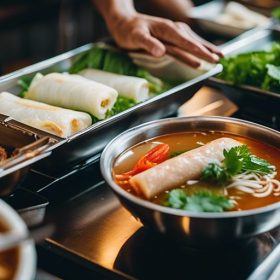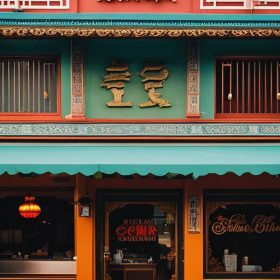Globalization has had a profound impact on various aspects of society, including food culture. As countries become more interconnected through trade, travel, and communication, the exchange of ideas, ingredients, and cooking techniques has become more prevalent. Vietnam, with its rich culinary heritage, has not been immune to this phenomenon. Over the years, the country’s food culture has been influenced by a variety of foreign ingredients and cooking styles, resulting in a unique fusion of flavors that is distinctly Vietnamese.
Vietnam’s food culture is known for its fresh ingredients, vibrant flavors, and balance of textures. Traditional Vietnamese cuisine is characterized by the use of herbs, vegetables, and seafood, as well as the incorporation of various spices and condiments. However, with the advent of globalization, new ingredients and cooking techniques have made their way into Vietnamese kitchens, adding depth and diversity to the country’s culinary landscape.
The Role of Foreign Ingredients in Vietnamese Cuisine: A Historical Perspective
Foreign ingredients have been incorporated into Vietnamese cuisine for centuries. Throughout its history, Vietnam has been influenced by various cultures and civilizations, each leaving their mark on the country’s food culture. From Chinese traders to French colonizers, these foreign influences have shaped the way Vietnamese people cook and eat.
One example of a foreign ingredient that has become a staple in Vietnamese cooking is rice. Rice was introduced to Vietnam by Chinese settlers over 2,000 years ago and quickly became a dietary staple. Today, rice is an essential component of many Vietnamese dishes, such as pho (rice noodle soup) and com tam (broken rice).
Another example is soy sauce, which was brought to Vietnam by Chinese traders. Soy sauce is used in many Vietnamese dishes to add depth and umami flavor. It is often used as a dipping sauce or as a seasoning in stir-fries and marinades.
The Influence of Chinese Ingredients on Vietnamese Cuisine
China has had a significant influence on Vietnamese cuisine due to its historical and cultural ties with Vietnam. The two countries share a long border and have a history of trade and cultural exchange. As a result, many Chinese ingredients and cooking techniques have been incorporated into Vietnamese cuisine.
One example of a Chinese ingredient that has become popular in Vietnamese cooking is tofu. Tofu is made from soybeans and is a versatile ingredient that can be used in a variety of dishes. It is often used in stir-fries, soups, and vegetarian dishes.
Another Chinese ingredient that has made its way into Vietnamese cuisine is black bean sauce. Black bean sauce is made from fermented black beans and is used as a flavoring agent in many Chinese dishes. In Vietnam, it is often used in stir-fries and noodle dishes to add depth and complexity to the flavors.
The Impact of French Ingredients on Vietnamese Cuisine
French colonization in Vietnam from the late 19th century to the mid-20th century had a profound impact on the country’s food culture. The French introduced new ingredients, cooking techniques, and culinary traditions that have become an integral part of Vietnamese cuisine.
One example of a French ingredient that has been incorporated into Vietnamese cooking is baguette bread. The French introduced baguettes to Vietnam, and they quickly became a popular staple in the country’s cuisine. Today, banh mi, a Vietnamese sandwich made with baguette bread, is one of the most iconic dishes in Vietnam.
Another French ingredient that has become popular in Vietnamese cooking is butter. Butter is used in many Vietnamese dishes to add richness and flavor. It is often used in sauces, marinades, and pastries.
The Role of Indian Spices in Vietnamese Cooking
India has had a long history of cultural exchange with Vietnam, dating back to ancient times. Indian spices have played a significant role in Vietnamese cooking, adding depth and complexity to the flavors of many dishes.
One example of an Indian spice that has been incorporated into Vietnamese cuisine is curry powder. Curry powder is a blend of various spices, such as turmeric, cumin, coriander, and chili powder. It is used in many Vietnamese dishes to add a warm and aromatic flavor.
Another Indian spice that is commonly used in Vietnamese cooking is cardamom. Cardamom is a fragrant spice that adds a unique flavor to dishes. It is often used in soups, stews, and desserts.
The Influence of Thai Ingredients on Vietnamese Cuisine
Thailand and Vietnam share a long history of cultural exchange and trade. As a result, Thai ingredients and cooking techniques have made their way into Vietnamese cuisine, adding a touch of Thai flavors to many dishes.
One example of a Thai ingredient that has been incorporated into Vietnamese cooking is fish sauce. Fish sauce is a staple in both Thai and Vietnamese cuisines and is used as a seasoning and condiment. It adds a salty and savory flavor to dishes and is often used in marinades, dipping sauces, and soups.
Another Thai ingredient that is commonly used in Vietnamese cooking is lemongrass. Lemongrass has a citrusy and aromatic flavor and is often used in soups, stir-fries, and marinades. It adds a refreshing and fragrant note to dishes.
The Impact of American Ingredients on Vietnamese Cooking
The Vietnam War had a significant impact on Vietnam’s food culture, particularly in the southern part of the country where American troops were stationed. American ingredients such as canned goods, processed foods, and condiments made their way into Vietnamese kitchens during this time.
One example of an American ingredient that has been incorporated into Vietnamese cuisine is mayonnaise. Mayonnaise was introduced to Vietnam by American soldiers and quickly became popular as a condiment for banh mi sandwiches and other dishes.
Another American ingredient that has made its way into Vietnamese cooking is ketchup. Ketchup is often used as a dipping sauce or as a flavoring agent in stir-fries and marinades.
The Role of Japanese Ingredients in Vietnamese Cuisine
Japan and Vietnam have a long history of cultural exchange and trade. Japanese ingredients and cooking techniques have influenced Vietnamese cuisine, adding a touch of Japanese flavors to many dishes.
One example of a Japanese ingredient that has been incorporated into Vietnamese cooking is soy sauce. Soy sauce is used in many Vietnamese dishes to add depth and umami flavor. It is often used as a dipping sauce or as a seasoning in stir-fries and marinades.
Another Japanese ingredient that is commonly used in Vietnamese cooking is miso paste. Miso paste is made from fermented soybeans and adds a rich and savory flavor to dishes. It is often used in soups, marinades, and dressings.
The Influence of Korean Ingredients on Vietnamese Cooking
Korea and Vietnam share a long history of cultural exchange and trade. Korean ingredients and cooking techniques have made their way into Vietnamese cuisine, adding a touch of Korean flavors to many dishes.
One example of a Korean ingredient that has been incorporated into Vietnamese cooking is gochujang. Gochujang is a fermented chili paste that adds a spicy and savory flavor to dishes. It is often used in marinades, sauces, and stews.
Another Korean ingredient that is commonly used in Vietnamese cooking is kimchi. Kimchi is a fermented vegetable dish that adds a tangy and spicy flavor to dishes. It is often used as a side dish or as an ingredient in soups and stir-fries.
The Impact of Italian Ingredients on Vietnamese Cuisine
In recent years, Italian cuisine has gained popularity in Vietnam, with Italian restaurants opening up across the country. Italian ingredients such as pasta, olive oil, and tomatoes have made their way into Vietnamese kitchens, adding a touch of Italian flavors to many dishes.
One example of an Italian ingredient that has been incorporated into Vietnamese cooking is pasta. Pasta is often used in Vietnamese dishes such as stir-fries and soups, adding a unique texture and flavor.
Another Italian ingredient that is commonly used in Vietnamese cooking is olive oil. Olive oil is used as a cooking oil and as a flavoring agent in many dishes. It adds a rich and fruity flavor to dishes.
The Future of Vietnam’s Culinary Scene in a Globalized World
Globalization has had a profound impact on Vietnam’s food culture, with foreign ingredients and cooking techniques becoming an integral part of Vietnamese cuisine. The fusion of flavors from different cultures has created a unique culinary landscape that is distinctly Vietnamese.
As Vietnam continues to embrace globalization, it is likely that the country’s culinary scene will continue to evolve. With increased travel and exposure to different cuisines, Vietnamese chefs and home cooks are experimenting with new ingredients and cooking techniques, creating innovative dishes that blend traditional Vietnamese flavors with global influences.
However, it is important to preserve the authenticity and integrity of traditional Vietnamese cuisine. While foreign ingredients have added depth and diversity to Vietnamese cooking, it is essential to maintain the balance of flavors, textures, and techniques that make Vietnamese cuisine so unique.
In conclusion, globalization has had a significant impact on Vietnam’s food culture, with foreign ingredients and cooking techniques becoming an integral part of Vietnamese cuisine. From Chinese and French influences to Indian, Thai, American, Japanese, Korean, and Italian flavors, Vietnam’s culinary scene has been enriched by the fusion of different cultures. As Vietnam continues to embrace globalization, it is important to preserve the authenticity of traditional Vietnamese cuisine while also embracing new flavors and techniques. The future of Vietnam’s culinary scene in a globalized world is bright, with endless possibilities for innovation and creativity.

Cuong Nguyen is a talented writer and experienced waitress at Vietnampalace.net, a renowned Vietnamese restaurant that offers an extensive menu of authentic Vietnamese cuisine. With a background in the competition of Vietnamese cuisine, Cuong brings a wealth of knowledge and expertise to the dining experience. From delicious pho dishes to fresh spring rolls, Cuong ensures that every meal is made with the freshest ingredients and authentic flavors.With exceptional service and a friendly atmosphere, Cuong takes pride in providing a memorable dining experience for every customer.
Whether you’re a vegetarian looking for options or a meat lover craving the flavors of traditional Vietnamese dishes, Cuong guarantees a delightful culinary adventure. So, visit Vietnampalace.net and let Cuong guide you through the tantalizing world of Vietnamese cuisine.



